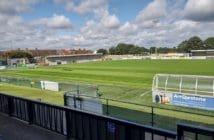Over the last few weeks, the Essex football scene in the EFL has been threatened by relegation in League Two as both Southend United and Colchester United fight for survival as they bid to stay in the Football League.
The U’s have had a crazy season so far however in recent weeks, Colchester United chairman Robbie Cowling finally decided to remove Steve Ball as manager after just short of seven months in charge following the departure of long-standing John McGreal who departed last summer after four years in the hot seat.
Wayne Brown (pictured above), who had been involved as manager of Isthmian North side Maldon & Tiptree whilst also having ties with Colchester earlier in the season, had been placed in temporary charge in a bid to get good results and drive the U’s away from the relegation zone.
Brown didn’t succeed in doing that so former-player Hayden Mullins has now stepped in for the rest of the campaign to hopefully save the club from relegation down to non-league football.
As we wrote in our piece about Colchester’s local neighbours and rivals Southend United a few weeks ago, we mentioned how damaging it would be for them to get relegated to the National League.
Until recently, it wasn’t thought that there is a risk of two sides from the same county being relegated in one season as it has become a thing that simply hasn’t happened before in the history of the Football League since there were two mandatory relegation spots for the bottom two sides in League Two.
In all fairness here, the closest we’ve ever got to such a feat was a regional relegation involving Torquay United and Bristol Rovers (pictured below) in 2013-14.
Both clubs are classed as being in the West Country of the UK so if both Essex clubs were to get relegated from League Two to the National League, it would be the first instance ever of two teams from the same county being relegated from the Football League to the National League.
For Colchester, the last few months have seen them go from comfortable Play-Off contenders to falling down the league and into disarray having still not won a game since December 8th and only gaining four out of nine points over local rivals Southend United and Leyton Orient this season with the U’s managing a 2-1 victory over the O’s back in November.
The effects of both Southend and Colchester being relegated from League Two could simply be quite problematic for the rest of the county.
There could be more demand on people who used to watch either team in action go and watch other nearby local sides in the Football League or Premier League like Leyton Orient, West Ham and Ipswich Town once fans return to grounds in the masses.
It could see attendances drop at both Essex sides as can be the case when any team gets relegated from any division across the world.
With relegation comes an earlier start in competitions so for the FA Cup, it could be Colchester’s first time back in the Fourth Qualifying Round since November 1991 when they overcame Burton Albion 5-0 at their old Layer Road ground. For Southend, it’ll be the first time since 1925 when they lost 2-1 at Reading in the Fifth Qualifying Round in their last appearance as a club participating in the Qualifying Rounds.
That appearance being back when the club was playing at the famous Kursaal Ground that is no longer around and hasn’t been their home since 1955 when the club moved into Roots Hall and have been there ever since (pictured below).
Southend haven’t played in non-league football for over 100 years since leaving the Southern League to join the Football League as members of the Division Three South in 1920 so such a move like relegation into the National League would be massively devastating to say the least.
For a club who were pushing for promotion to the Championship a little less than five years ago if not even less than that whilst in League One.
Like teams before them, Southend would be no doubt following in the steps of Yeovil Town, Luton Town, Leyton Orient and many others who have endured successive relegations from League One to the National League within a few years over the past 20 years.
That being said, whilst relegation isn’t something that everyone likes, it’s something that to those in the lower tiers of football are used to and have endured it at least once or twice before.
Southend fans between 2000 and 2020 aren’t excused from that as they have endured four promotions but in return, have seen four relegations unfold. If things carry on, it could be their fifth relegation in the last 21 years, and maybe the most devastating relegation.
Every time you get relegated it hurts like the first time but after every time it happens, it’s vitally important the club involved picks itself up, dusts themselves clean of the past season of error and most importantly, goes again but with a fresh perspective and a clean break of opportunity to get back to where they feel they belong.
Southend spent over five years during the last decade desperately trying to climb out of League Two in the hope of playing Championship football once more after their one-season wonder back in 2006-07 (which included a famous 1-0 victory over Manchester United in the League Cup Fourth Round).
They found themselves making some woeful signings with players on big wages, but were not given the big performances in return for their given paychecks whilst they aspired to reach the second tier of English football once more alongside the hope that a new stadium added in would secure them a dream similar to that of Brighton.
Swansea and Hull have moved into new stadiums and find themselves mixing and playing with England’s elite players from the Premier League and Championship.
The problem lies deeper for Southend. Ultimately, not recruiting the key positions of those who departed for new challenges has also hurt massively. People like Steve Kavanagh, Graham Coughlan and Kevin Maher have all gone away from Roots Hall without a replacement being good enough or successful since their days in Essex came to an end.
The same could be said for many players. Stars like Ryan Leonard, Luke Prosser, Michael Timlin, Mark Phillips among many others haven’t been replaced properly either with signings like Liam Ridgewell and Michael Turner who were washed up signings looking for a last payday at a reasonable level of football despite not often delivering the paycheck they were picking up from the paying fans coming into Roots Hall every fortnight.
Colchester themselves are in a similar predicament. They moved into the Colchester Community Stadium in 2008 with hopes of achieving bigger and better success with a new state of the art stadium that can hold over 10,000 people of which even now, has the potential to be expanded should more people attend in the future.
It is also worth noting that Layer Road had been the home of the U’s since 1937 and had a meagre of just over 6,300 so it was an increase well done, to say the least.
However, whilst Southend were spending much of the last decade aiming to get out of League Two, the U’s in Colchester stagnated in League One after four top-half finishes following their relegation from the Championship.
The following four campaigns saw the club finish in the bottom half of which the last was to be the straw that broke the camels back in 2016 as Southend finished higher than them in their first season back in the same division.
If the unfortunate happens with both or even one returning to the non-league setup, it would also mean a return for Colchester to the FA Trophy in which their last appearance saw them go all the way and win the competition with a 3-1 victory over Witton Albion at the Old Wembley Stadium in 1992 whilst for Southend, it would be the first-ever run in non-league’s biggest cup competition.
However, it won’t be till Round Three that either will partake in either competition which is normally held around December time as all 24 National League sides enter the competition at the stage as per the norm.
Any chances of them taking on fellow Essex non-league sides like this season’s FA Trophy finalists AFC Hornchurch or even last seasons yet-to-played FA Trophy finalists Concord Rangers could be in doubt somewhat, but never say never to such a game being played as 24 clubs from Essex normally enter the competition every season.
That being said, the two Essex sides lock horns with each other in a relegation battle showdown on April 20th whilst the chance for both to bring Barrow back into contention with games played on April 5th (for Colchester) and 1st May (for Southend) could also be worth something.
Whilst it could be seen that Colchester have the tougher run-in with their final three games against high flying Cheltenham, Salford and Tranmere, Southend have a mixed run-in to the end of the campaign with Leyton Orient, Barrow and Newport County all set to be faced in their final three games. Two of which are pushing for the Play-Offs.
That said, Grimsby (pictured above) have an even tougher task with games against Bolton, Cambridge and Morecambe all set to come along still for them. If Colchester, Southend and Grimsby grab the points they need, they could even be set to bring the likes of Walsall, Mansfield and maybe even Oldham into the relegation dogfight for survival.
Whatever happens, there will no doubt be winners and losers from this season and maybe Essex might see both situations being the case from this scenario ahead.
Follow us on Twitter @ProstInt
EFL
League Two
League Two
![Prost International [PINT]](https://prostinternational.com/wp-content/uploads/2021/08/PINTtFontLogoRoboto1536x78.jpg)


